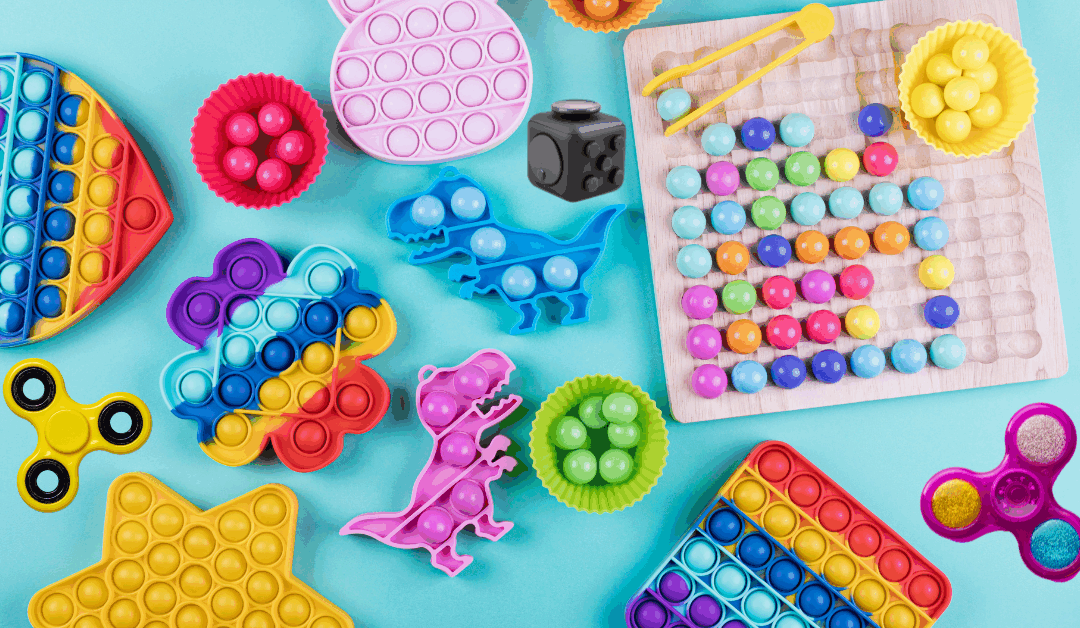You’ve probably seen them: spinners, cubes, squishy things, poppers in every color of the rainbow. At first glance, they might seem like toys meant just for kids—but fidget toys?
Oh, they’re so much more than a trend.
Whether you’re a parent, teacher, therapist, or someone who simply can’t sit through a Zoom meeting without clicking your pen 87 times, fidget toys might be your new best friend.
These little tools are rooted in science, and they’re changing how people of all ages regulate, focus, and manage stress.
Let’s break down what fidget toys actually are, why they work, and how they support both kids and adults in staying calm, focused, and engaged in the moment.
What Are Fidget Toys?
Fidget toys are small, handheld objects designed to provide sensory input and physical movement that helps regulate the nervous system. Think of them as outlets for restless energy—ways to move, touch, squeeze, or spin that give your body the activity it craves without disrupting the task at hand.
They can be simple or complex, quiet or clicky, soft or textured. Common examples of fidget toys include:
- Stress balls
- Fidget spinners
- Tangle toys
- Pop-it boards
- Fidget cubes
- Marble-and-mesh tubes
- Chewelry (chewable jewelry)
- Sensory rings
- Putty or slime
And while they’re often associated with children (especially those with ADHD, autism, or sensory processing challenges), adults benefit from them too.
Because honestly—who doesn’t need a little help focusing sometimes?
What Are Fidget Toys Used For?
Here’s the fun part—fidget toys may look like simple gadgets, but their use is backed by some serious science. They tap into something called “self-regulation,” helping people manage their emotions, attention, and energy levels.
Here’s what fidget toys are commonly used for:
1. Improving Focus
Sounds backwards, right? Move more to focus better? But studies show that for many people—especially those with ADHD—engaging in small, repetitive motor movements can actually increase concentration. Fidgeting helps the brain stay alert.
2. Managing Anxiety and Stress
Squeezing a stress ball or rolling a sensory ring can be calming during anxious moments. It gives your hands something to do, which can ground you when your thoughts are spiraling.
3. Supporting Emotional Regulation
For kids and adults alike, fidget toys can serve as a coping strategy when emotions feel overwhelming. Using a fidget toy can offer a pause, a moment of relief, and a chance to regroup.
4. Enhancing Sensory Processing
Some people seek tactile or movement input to feel balanced. Fidget toys meet these needs in a non-disruptive way, helping with sensory integration and self-soothing.
5. Aiding in Mindfulness
Believe it or not, fidgeting can be a form of mindfulness. Tuning into the texture, movement, or resistance of a toy can pull you out of your head and into the present moment.
So whether you’re sitting in class, on a plane, in a waiting room, or at work, fidget toys can help you feel more centered and more in control of your energy.
What Are the Best Fidget Toys for Adults?
Kids love bright colors and squishy textures, but let’s be real—adults get stressed too. And yes, there are plenty of grown-up-friendly fidget toys that are subtle, sleek, and actually enjoyable to use.
Here are some favorites for adults who want a little sensory support (without pulling out a neon pop-it at the board meeting):
1. Fidget Rings
These look like stylish jewelry but have a moveable component (like spinning beads or textured bands) that you can discreetly use to calm your nerves or stay focused.
2. Stress Balls or Therapy Putty
Perfect for meetings, deep thinking, or high-stress situations. Some come with resistance levels, so you can squeeze to your heart’s content.
3. Metal Hand Rollers or Gyroscopic Balls
Smooth, weighted rollers fit perfectly in your palm and provide soothing pressure and motion. Bonus: they look kind of fancy.
4. Infinity Cubes
These small, foldable cubes offer endless flipping, clicking, and folding, all in a compact form that fits in your desk drawer or pocket.
5. Sensory Keychains or Textured Clips
Clipped onto your keys or bag, these low-profile options offer sensory input without drawing attention.
Whether you’re in therapy, the classroom, or your home office, fidget toys are about meeting yourself where you are—anxiety, restlessness, and all.
Why Are Fidget Toys Helpful?
Let’s answer the big question: why do these seemingly simple gadgets help so many people?
The answer lies in the brain-body connection. Our nervous systems crave regulation. For some people, that comes from stillness and silence. For others, it comes from movement. And for those with neurodivergent wiring (like ADHD or autism), that movement isn’t optional—it’s essential.
Here’s why fidget toys are helpful:
1. They Support the Brain’s Alerting System
Fidgeting stimulates the brain’s frontal lobe—the part responsible for attention and problem-solving. So when your fingers are busy, your brain can actually focus better.
2. They Help Manage Energy and Impulses
Rather than pacing, tapping, or interrupting, fidget toys offer a contained, acceptable outlet for excess energy.
3. They Calm the Nervous System
Repetitive motion, texture, and tactile stimulation help regulate the autonomic nervous system—especially during fight-or-flight responses. Translation? They help you feel safe.
4. They Promote Self-Awareness and Coping
Using a fidget can become a powerful cue to pause, check in with your body, and soothe yourself before things escalate.
5. They Empower Self-Advocacy
Having a fidget toy on hand sends a powerful message: “I know what I need, and I’m taking care of myself.” That’s emotional intelligence at work.
Fidgeting isn’t a flaw—it’s a need. And fidget toys give people the tools to meet that need without shame.
Final Thoughts: Fidgeting Is Human—Let’s Normalize It
If you’ve ever felt judged for being “too fidgety,” “distracted,” or “unable to sit still,” this is your reminder: movement is not a weakness. For many of us, it’s a path to presence, clarity, and calm.
Fidget toys aren’t distractions. They’re tools. Tools that help brains focus, bodies self-regulate, and emotions feel more manageable.
Whether you’re 7 or 57, these little objects can bring big relief.
So go ahead—click that cube, squish that putty, spin that ring. You’re not doing it wrong. You’re giving your body and brain the support they need to stay engaged, calm, and connected.
And that? That’s something to celebrate.
Want A Helping Hand?
Hope Human Services provides disability services in Washington State. Our team doesn’t just provide support, we create exceptional life experiences.

